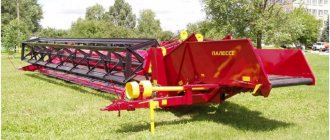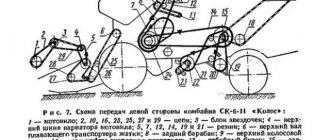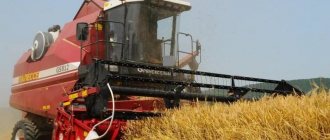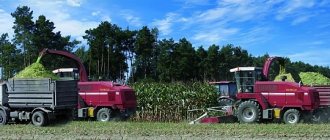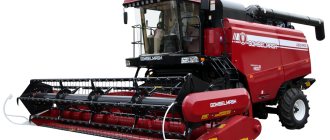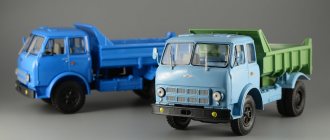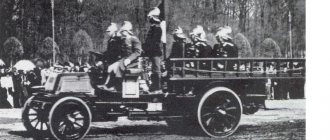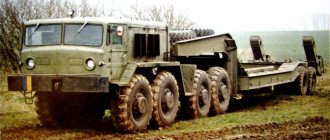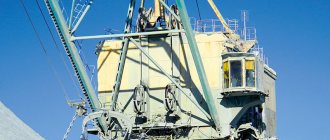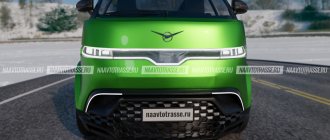656922 Barnaul, Vlasikhinskaya str. 192 Postal: Barnaul, PO Box 4157
Equipment sales department - +7 (3852) 500-533 E-mail
Service center - +7 (3852) 502-511 Spare parts sales department - +7 (3852) 502-533 E-mail
Financial and legal department — +7 (3852) 500-511
Dear users and owners of these combines, write your reviews about this combine produced by Bryanskselmash, a subsidiary of Gomselmash Production Association.
Last year I bought Polesie 1218. The paint is falling off everywhere, the side broke down during harvesting in 2008 - they replaced it - it leaks again, the header is worn out, the header falls on the left side, the sieves cling to each other, the automation system does not work (loss control). Warranty repairs are not carried out. There are about a hundred faults, both DESIGN and PRODUCTION. Two years of warranty IS A DECLARATION OF GOMSELMASH and NOTHING MORE. A service life of 10 years is GOMSELMASH’S DECLARATION and no MORE, God bless him if he works for five years. The neighbors chuckle that I bought this miracle of Polesie 1218. The cart for transporting the reaper has a rear axle welded crookedly, and in just one season the rubber on the rear wheels of the reaper cart has been eaten away. So, the warranty workers came in 2008, shook their heads, and left, but I had to buy a new pair of tires. This is the quality of the GOMSELMASH product and guarantee. At the end of the 2009 season, I plan to do a full technical inspection of the Polesye 1218 combine with the application of the ROSTEKHNADZOR ACT. and of course I will publish these materials on websites
And now the facts, and they are the facts: I bought a Polesie 1218 grain harvester in Kursk for 3,900,000 rubles on June 25, 2008, walked 1000 km from Kursk to the South, harvested 580 hectares, drove 200 km on foot, harvested 180 hectares, walked 600 km I harvested 460 hectares of grain, then I traveled 700 km on foot and harvested 580 hectares of sunflowers, and this was in 2008. And how? My tests: John Deere 9640 and Polesie 1218 walked side by side in the same field, the yield was about 40 c/ha, average weight, the bunkers were filled at the same time, second per second, and the combine operators did not know that I was keeping records, there were losses in both combines normal, I specifically personally climbed the field and looked for it. But we must take into account that I slightly improved the cleanup in Polesie. The purity of the grain was the same, although John Deere had a slightly larger harvest.
For this year 2009 I do not report
In 2009, in the South, 630 hectares were harvested with this combine, and in the Voronezhuka region, another 580 hectares, and then in the Rostov region, in different places, a total of about 680 hectares of sunflowers, and all this was covered on foot. Pros and cons? And for what other equipment (grain harvesting) in Polesie (KZS 1218), have you seen a 2-year warranty, including on the engine, in the sense of a GUARANTEE in the free repair of all breakdowns promptly within 24 hours. and not the guarantee that sellers of other equipment offer: they guarantee that they will fix the faults for my money. The advantage of Polesie 1218 (KZS-1218) is TWO: 1. - accelerator drum, since I don’t consider other manufacturers from MEGA, relative to Rosselmash. 2. — the cost is significantly LOWER than ALL similar other combine harvester manufacturers, with the same tactical and technical data.
But there is something more specific. What are the pros and cons compared to another manufacturer. I just enter the market and will sell these agricultural cars and I need to know everything! Literature doesn’t give much away from the Internet either! I'm asking you for help. thank you in advance!!
Grain harvesters KZS-1218 "Polesie GS12" and KZS-812 "Polesie GS812" are modern high-performance agricultural machines produced in the Belarusian city of Gomel. They are characterized, first of all, by high-quality grinding, excellent harvesting speed, efficiency, ease of movement, endurance to loads, and a comfortable cabin. Let us examine in detail what the features of each of these models are, and how they performed in real operating conditions.
About history
OJSC Gomselmash today is one of the largest agricultural machinery production enterprises in the post-Soviet space, employing more than eight thousand people. This production was preserved during the years of perestroika and the subsequent total ruin of Soviet industry.
In the 2000s, the company developed dynamically and systematically and continues to develop. Therefore, now Gomselmash no longer produces individual agricultural machines, as before, but full-fledged model ranges of agricultural machinery for various purposes, trying to cover all the main technological processes of crop production - from complex tillage and sowing to harvesting. And occupy all market niches, satisfying the needs of both small farmers and larger agro-industrial farms.
Permanent representative offices of OJSC Gomselmash operate not only in Russia and neighboring European countries, but also in distant Argentina and China. And in Bryansk, Kazakhstan (Kustanay), Tatarstan, and in China, joint production of products from the plant’s model range has been launched. The company's two Chinese factories annually produce several thousand units of forage and cob harvesters.
Gomselmash traces its history back to 1928, when the construction of a plant for the production of agricultural machinery began in Gomel. The birthday of Gomselmash is considered to be October 15, 1930, when the foundry of the enterprise produced its first smelting. By the beginning of the Great Patriotic War, the plant was already producing three dozen types of agricultural machinery, 18 types of which, by the way, were also exported to other countries.
Despite the rapidity of the Nazi offensive in 1941, they managed to evacuate to the Urals: about 1,100 wagons with plant equipment and unfinished products arrived safely, along with leading workers and specialists, to the city of Kurgan. Already on August 26, 1941, the plant produced the first batch of its new products: mortars and ammunition for them.
The material and technical base of the plant in Belarus, devastated by the war, was restored in three years (1944-1947); and in 1950, Gomselmash had already doubled its pre-war annual production volumes. The main specialization of the enterprise in the Soviet years was the production of silage and other forage harvesters: first trailed, and since 1977 - self-propelled.
Automatic workshop at
Serial production of grain harvesters at Gomselmash was established at the turn of the 90s and 2000s. This made it possible to quickly and cost-effectively remove outdated and uneconomical Niva and Don combine harvesters from use on the republic’s farms; at the same time, also covering more and more new sales markets, in the vastness of the former Union and beyond its borders.
Technical characteristics of the Polesie-1218 combine
The sixth-class grain harvester “Polesie-1218” is a unit, first of all, powerful and highly productive, equipped with a 1500 mm wide threshing and separating device, which uses acceleration of the flow of grain mass before threshing. The designers tried, however, to make it as universal as possible, for any specific formats and working conditions.
Design features of KZS-1218
For example, the use of a header with a nine-meter working width makes the use of the combine effective in fields with medium and low yields, significantly reducing the number of passes across the field and fuel consumption.
To work with a 9.2 m header, the combine is equipped with an unloading auger, the length of which is increased by 1 meter. This ensures free access for vehicles to unload grain.
The Polesie-1218 grain harvester can additionally be equipped with a steered drive axle. A combine with two drive axles has increased cross-country ability and is capable of harvesting crops in difficult conditions: on heavy soils, during prolonged rains and in the autumn harvesting of corn for grain, which significantly increases its seasonal operating time. In addition, it is possible to work on twin wheels, which helps when harvesting waterlogged fields.
The efficiency of using the combine is increased with the use of additional adapters for harvesting various crops, by re-equipping the thresher (for harvesting corn for grain and sunflower), the thresher and the chassis (for harvesting rice).
Capabilities of the harvester of the Polesie-1218 and Polesie-812 combines
The cutting apparatus is equipped with durable stamp-welded fingers, which have two cutting edges at the top and bottom, with a system of alternating segments with an up/down notch. It gives an exceptionally clean cut and is self-cleaning.
The planetary gearbox used to drive the cutting apparatus of the header creates a high cutting frequency (1108 strokes per minute), with smooth running and minimal wear, increasing overall productivity.
The use of hydraulic-pneumatic accumulators on the hydraulic cylinders for raising and lowering the feeder chamber improves the quality of the header's copying of the field topography, and also prevents annoying damage to the header and feeder chamber from these irregularities.
Easily installed accessories for harvesting rapeseed allow you to extend the header table. Active side dividers with fingerless cutting devices cut the harvested rapeseed precisely along the edge of the pen. In combination with special rapeseed reflectors, this reduces rapeseed loss to a minimum.
Special attachments of the corn header include a cob and stalk chopper, a reduction drive for the threshing drum, a replaceable concave and additional equipment for the combine's working systems.
The cobs are carefully separated from the general feed mass and served for threshing, and the stems are finely crushed for silage. After such harvesting, the field remains completely ready for plowing.
Threshing system of the Polesie-1218 combine
The accelerator drum speeds up the movement of the grain mass, which comes from the feeder conveyor, and brings it closer to the rotation speed of the threshing drum. The accelerator is equipped with a primary concave, so the threshing and separation process starts already at the stage of flow acceleration.
Further, the teeth of the accelerator drum work to ensure uniform mass distribution. This helps reduce the load on the threshing drum and main concave. These features make threshing stable and efficient, and provide the combine with a noticeable advantage when harvesting curled and wet grain.
Straw walker and cleaning system
The five-key straw walker is equipped with 7 cascades, with an optimal height difference on each of the keys. The amplitude of the counter movement of the keys is large, which helps to improve the separation of grain from the straw heap, maintain stable productivity and overall reduce losses. The sieve mill has a large area, three cleaning cascades, and a powerful turbofan with uniform distribution of air flow across the sieves.
This modern cleaning system ensures the highest requirements for bunker grain purity.
The intensity of the air flow can be adjusted by an electric mechanism, which is controlled by a button from the cabin and smoothly changes the speed of rotation of the cleaning fan. The feeder chamber of a modern design is characterized by a high degree of reliability, stable and high-quality supply of grain mass, and ensures high productivity, combined with threshing quality.
Grain storage tank and fuel tank
The volume of the grain tank of the Polesie-1218 combine is 8 cubic meters. This volume is very convenient, given that grain trucks based on KamAZ are most often used in agriculture. Each such truck can hold exactly two full bins. And this allows for clear and uninterrupted removal of harvested grain, completely eliminating equipment downtime.
The spacious fuel tank (volume 600 liters) provides the combine with good continuous operation without refueling. By the way, it is not metal, but plastic, made of durable polymer materials.
Other technical characteristics of Polesie-1218 in numbers
• Engine: “YAMZ-238DE” with a power of 330 hp. (243 kW) • Dimensions in working position, with a 7 m header (length*width*height): 11.2*7.6*4.65 meters; • in transport position: 18.1*3.9*4 meters; • Weight (without transport trolley) – 16.6 tons.
Messages [13]
1 Topic by actyon 07-11-2013 17:52
- actyon
- Tractor driver
- Inactive
- Registered: 07-11-2013
- Messages: 18
Topic: Help me choose a combine harvester
Help me choose a new combine: vector 410, Palesse 812, Palesse 10. Region - Chernihiv region. Thank you.
2 Reply from dvs 07-11-2013 17:53 Edited by dvs (07-11-2013 17:55)
- dvs
- Tractor driver
- Inactive
- Registered: 07-11-2013
- Messages: 19
Re: Help me choose a combine harvester
Google it. I quote: Price-quality, I’ve had it for 5 years, the load is 800 hectares of grain, I have everything my heart desires in a zipper. I haven’t bought a single part in 5 years, all the little things are in a zip, the knife hasn’t become dull in 5 years, I’ve replaced 10 segments (from a zip), not a single belt or bearing. If the weather during harvesting is humid, then it is not even close to anything; it doesn’t even smell anything wet with grass, the second drum helps a lot. The average harvesting speed is 8 km per hour, depending on the levelness of the field. In our area there was the very first one of these, now all the neighbors have taken it too. In the neighboring joint venture there are 2 of them with a load of 2.5 thousand hectares each, they rape as best they can, they almost keep up with the rotary foreign cars. Nothing major broke. The weak point is the straw walker drive shaft, the metal is bad, they themselves admit that it was replaced under warranty 1 time and 1 time by a neighbor. The electrics are not glitchy. From new, it’s better to turn off the sensor on the hopper lid and that’s it, otherwise the thresher will turn off. Convenient trolley for the header, on 4 wheels (and not 2 as on the Akros) The header can be removed in 15-20 minutes right in the field. The spare knife is hidden in the header. Disadvantages: The kit does not come with a pick-up. With a yield of over 40, it eats like a horse, 500 liters in 12 hours without a break, but the output is appropriate. With a low yield of 7-12 quintals, the header needs 20 or better 30 meters, otherwise it’s useless to drive around the field and roll away the current. At the beginning, I also chose either vector or 812, for 800 hectares of sowing with 3 fields it would be enough, but I did not regret that I spent the extra money, the harvesting time was reduced by exactly 2 times. In 2011, the current threshed them, the rains flooded, the fields did not grow, and the neighbor’s dons did not grow. Current 1218 and New Holland rotary worked. If you need anything more specific, ask.
Cabin of combine harvesters "Polesie-1218" and "Polesie-812"
The cabin on these combines is spacious, noise- and vibration-proof, with panoramic glazing and excellent visibility in all directions. The cabin is equipped with air conditioning, an automatic monitoring and control system based on a modern on-board computer.
The operator’s workplace is organized successfully and “wisely”, in full accordance with modern achievements of ergonomics. Combined with a high level of comfort, this helps to maintain the high performance of the combine operator throughout the long working shift.
Combine harvester (Dobrynya-1500)
| New nodes and systems |
| motor power plant YaMZ-238 AK |
| cleaning "Novator Plus" |
| grain elevator |
| inclined grain auger |
| grain elevator |
| pre-threshing device |
| unloading auger 4m |
| hydraulic equipment of working bodies |
| hydraulic steering equipment |
| electrical equipment with battery |
| brake system |
| screw group |
| "Sprint-9" system |
| RVD, RTI, conveyors, bearings, chains |
| facing with fuel tank 300l |
| chopper |
| air conditioner |
| tires |
The Novator Plus cleaning system improves the quality of grain cleaning, reduces grain losses, and is more convenient to maintain. The “Sprint” system ensures optimal belt tension and increases their service life by 1.5-2.5 times. Increases the seasonal operating time of the combine. Comfortable cabin with air conditioning and sound insulation.
Owner reviews about the Polesie-1218 and Polesie-812 combines
The Polesie combine harvesters (as well as the work of the dealer network) received mixed reviews from peasants in the CIS.
Pros. On the one hand, both combines demonstrate high productivity and good harvesting power reserves. Where combines from other manufacturers lag significantly behind, “choking”, “Polesie” continues to work at the same pace, without feeling the load. This is especially true for “KZS-1218” - the presence of an accelerator drum affects it.
In terms of fuel efficiency, they are in no way inferior to foreign analogues. Gomselmash combines demonstrate a throughput capacity of at least 3 thousand tons of grain per season, and this with minimal losses.
Everyone notes that thanks to comfortable working conditions (climate control, very good noise, vibration and dust insulation of the cabin), you can work effectively on a combine for longer than on old-style combines. Which has a positive effect not only on the operator’s health, but also on reducing harvesting time.
Minuses. When moving uphill and on side slopes, grain losses increase significantly. The large total length of the accelerator deck and drum, as well as the insufficient elevation angle of the straw walker, have an effect.
Grain often flies out from behind, here it is necessary to install seals between the lower sieve and the grain shaking board; and between the lower and upper sieve. There are often problems with starting the straw chopper (the tips do not work). The quality of painting leaves much to be desired: the paint on combines fades quite quickly and falls off in places. As a result, the three-year-old Polesie combines take on the same appearance as the 10-year-old Rostselmashevskie combines.
The header often becomes deformed, wears out, and begins to fall on one side; the sieves cling to each other. There are complaints about the work of Gomselmash dealers: they do not always have the necessary spare parts and consumables in stock. In some cases, you have to wait so long that the very relevance of the repair is lost.
Run over by a combine harvester! We found out why Claas is good, but you should buy Palesse
August 14, 2022 at 18:52 Pavel Murashko / Photo: Oleg Kindar / AUTO.TUT.BY
Harvesting is in full swing. Directions, checks, deadlines - passions run high. And the combines break down. It is not without reason that the President of Belarus Alexander Lukashenko ordered to compare the number of failures of domestic agricultural machinery and the best foreign analogues. And the Ministry of Internal Affairs and the State Audit Office will report on cases of its failure.
Subsidized collective farms are required to purchase only domestic equipment
State agricultural enterprises, which are subsidized from the budget, have long been prohibited from buying imported equipment. Only Belarusian, that is, “Palesse”. Those Claas combines that we found on the field were purchased ten years ago. But, as the agronomist admits, they are still in operation and operate without failures or repairs. But ours...
Ten-year-old Claas holds up well even against the background of younger Gomselmash cars
What is the difference: speed, performance, comfort, reliability? Both Palesse and Claas are equipped with the same engines. This is an American Detroit Diesel with a power of about 330 “horses”. So there is not much difference in fuel consumption. The operating speed of combine harvesters varies. According to drivers, an imported one can do 7-8 km/h across the field, and a domestic one can do 4-5 km/h.
The Claas cabin features a comfortable seat and good finishing materials. Of course, in relation to agricultural machinery
The Claas combine driver's workplace is simple but ergonomic. The chair with a high back is no worse than in other foreign passenger cars; it is very comfortable to sit in. Naturally, there is also an air conditioner and it regularly cools the combine operator in the August heat. German thoroughness is felt in every detail.
The Palesse cabin lags behind in finishing quality, but overall looks good
The cabin of the Belarusian combine is simpler: the finishing materials are cheaper, the driver’s seat is just a seat, albeit with armrests. And the sound insulation is worse. But, to the credit of our manufacturer, there is an air conditioner in the cabin and even a cooled glove compartment where you can store water without fear that it will boil after a couple of hours of work in the sun.
We noticed that in the Palesse cabin there was also an assistant sitting next to the combine operator. As they explained to us, he monitors the equipment and carries out prompt repairs in case of breakdown. Meanwhile, the driver of the German combine was driving circles around the wheat field in splendid isolation. Coincidence? Maybe.
In terms of technical characteristics, which only a combine operator with extensive experience can understand, the products of the German and Belarusian manufacturers are practically the same - the width of the threshing drum, the area of the straw walker, the angle. But still, the specialist notes that Claas works more productively and leaves less waste.
Our combine harvesters have bearings and chains that are the most heavily loaded parts during operation. Hence the downtime and losses. And ten-year-old imported ones work without any problems at all. But that is until a stone hits. The combine operators admit that this is the biggest problem on the field. A stone hits - trouble. Breakdown is inevitable. And the stone doesn’t care whether the combine is imported or Belarusian.
Brief conclusions about the Polesie-1218 and Polesie-812 combines
The main advantages that persuade peasants to choose combines of this brand, with all the diversity of the agricultural machinery market, are special subsidy programs and real economic feasibility. After all, imported combines are much more expensive, and that’s only half the battle - the biggest costs are repairs and maintenance of foreign equipment. Polesie combine harvesters, being much cheaper, are very cost-effective, economical, reliable, therefore they quickly pay for themselves and begin to make a profit.
Rules of operation and storage
In order for the combine to serve for a long time, it is necessary to follow some basic rules that guarantee long-term operation of agricultural machinery:
- Monitor the condition of the combine, do not allow corrosion to develop;
- Use recommended lubricants and fuel;
- Before use, check the serviceability of parts, the tension and integrity of the belts;
- Store in a special place where water will not enter the combine;
- Do not leave your workplace even when the equipment is standing in one area, if it is turned on;
- Purchase only certified parts and spare parts;
- Repair work must be carried out by professionals.
By following these simple rules, you will ensure a long life for your combine harvester.
Undoubtedly, such equipment will greatly facilitate your work in the field. Polesie combines are distinguished by their excellent quality and performance, so you will be more than satisfied with your purchase and will use it for many years.
